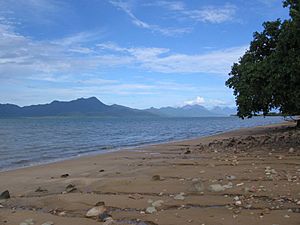Oyster Point (Australia) facts for kids

Oyster Point is a special place located at the mouth of Stoney Creek, about one kilometre south of Cardwell in northern Australia. It became famous for one of Australia's most important battles over protecting nature. A developer named Keith Williams wanted to build a huge housing area with canals, a resort, and a big boat marina here, called Port Hinchinbrook. This plan caused a lot of debate and concern among people who wanted to protect the environment.
Contents
Why Oyster Point Was Special
Oyster Point is near the beautiful Great Barrier Reef World Heritage Area and the Wet Tropics of Queensland World Heritage Area. These are very important natural places. The area is also home to amazing wildlife, like crocodiles and dugongs. Many people were worried that building a large development here would harm these sensitive environments and the animals that live there.
Early Concerns About the Site
Even back in 1977, a government report said that Oyster Point was not a good place for a boat harbour. This was because the water wasn't naturally deep enough. The report also warned that the area was prone to "siltation," meaning mud and sand would constantly move around and fill in any dredged areas. This would make it very hard to keep a marina open.
The Port Hinchinbrook Development Plan
In 1994, the local council and the Queensland Government approved the Port Hinchinbrook project. This caused a big split in the local community. Some people thought the project would bring many jobs and economic benefits. Others were very worried about the environmental impact.
How the Project Was Supposed to Work
The developer, Keith Williams, made an agreement with the local council and the Queensland and Commonwealth governments. This agreement said that the developer and the people who bought homes in the new area would be responsible for maintaining the roads, canals, and sewerage. This included all the dredging needed to keep the canals clear. This meant that the government would not have to pay for these ongoing costs.
Changing the Landscape
As part of the development, Stoney Creek was changed into a wide, deep canal called "Grande Canal." To do this, a lot of soil was dug out. This soil contained "acid sulfate soils," which can be harmful to the environment. Much of this dug-out soil was put into the Hinchinbrook Channel. The canal was made very deep to try and delay how often it would need to be dredged, because of the earlier warnings about siltation. However, by 2004, people living there started to notice a lot of silt.
Environmental Concerns and Protests
Environmental groups were very concerned about the Port Hinchinbrook development. They believed it was a serious threat to the Great Barrier Reef and the Wet Tropics. They were especially worried about the local dugong population, which was already small. They feared that more boats in the area would harm the dugongs and their food source, the seagrass meadows.
Stopping the Mangrove Clearing
In November 1994, after environmental groups spoke to the Australian government, a special order was made to stop the clearing of tall mangrove forests. These mangroves had been protected by activists who took turns watching over them 24 hours a day. When the order was made, work stopped, and the activists came down from the trees. However, that very night, the developer went against the order and cleared the forests using large swamp dozers under bright lights.
Legal Challenges and Continued Protests
Environmental groups, like Friends of Hinchinbrook Inc., continued to challenge the project in court. They argued that the development would harm the environment. The court eventually allowed the project to continue, but with strict conditions. One important condition was that the Queensland Government had to create a special plan to protect the Great Barrier Reef World Heritage Area from the development's effects.
Activists also continued to protest near the site. Sometimes, hundreds of people would gather to show their opposition. In 1997, a large group of people, including children, walked along public land near the development to protest. They were singing and showing their support for protecting the world heritage area.
Later Years of the Development
Over time, the "Port Hinchinbrook" housing development did not sell well. The developer tried to sell the project to the Queensland and Federal governments. After Keith Williams passed away in 2011, his son Ben Williams took over. However, the development site continued to have problems. Eventually, the development company went out of business.
Even in 2019, people connected to the development were still asking the local government to take over the maintenance of the roads and canals. This was against the original agreement that said the developer and homeowners were responsible for these costs.


